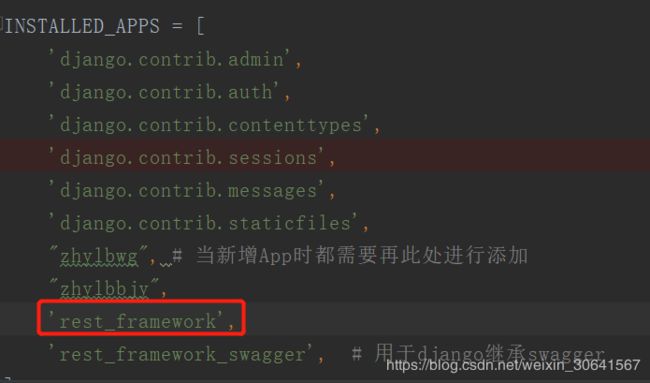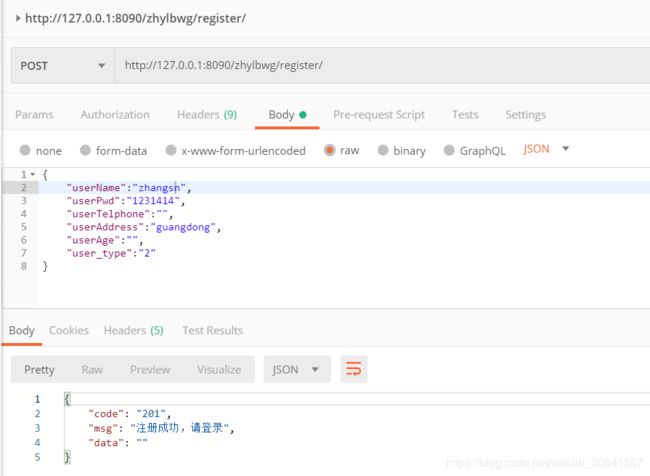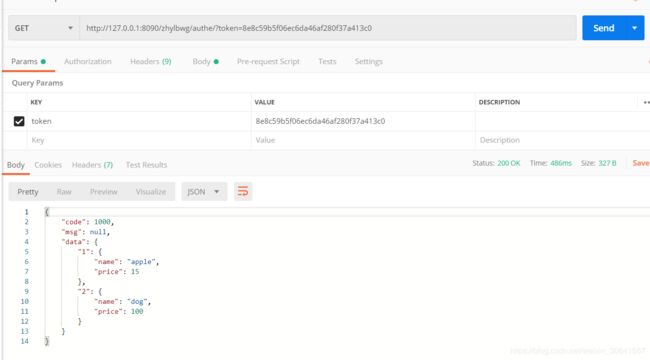Django REST Framework自定义token认证
目录
- 一:模块导入
- 二 :生成token
- 1:定义model,Userinfo和UserToken
- 2:执行数据迁移命令,生成表数据
- 3:用户注册
- 4:根据用户名生成token
- 三:自定义认证类
- 1:自定义认证类
- 3:配置url
- 4:测试接口
- 四:认证配置
一:模块导入
-
导入模块
pip install djangorestframeword # 使用pip命令进行djangorestFramework -
配置,在setting.py中进行如下配置
二 :生成token
1:定义model,Userinfo和UserToken
from django.db import models
'''===================================
@Project:wisdomShop
@Author:班婕妤
@Date:10/3/2020 下午2:14
@Company:深圳市智慧养老宝科技有限公司
@Motto:心有猛虎,细嗅蔷薇
@Python_Version:3.7.3
@Django_Version:2.1.5
======================================='''
class Userinfo(models.Model):
USER_TYPE = (
(1, '普通用户'),
(2, 'VIP'),
(3, 'SVIP')
)
user_type = models.IntegerField(choices=USER_TYPE, blank=True, null=True)
userName = models.CharField(max_length=10)
userPwd = models.CharField(max_length=100)
userTelphone = models.CharField(max_length=10)
userAddress = models.CharField(max_length=10)
userAge = models.CharField(max_length=4)
class UserToken(models.Model):
user = models.OneToOneField(Userinfo, on_delete=models.CASCADE)
token = models.CharField(max_length=64)
2:执行数据迁移命令,生成表数据
// An highlighted block
var foo = 'bar';
python manage.py makemigrations zhylbwg
python manage.py migrate zhylbwg
3:用户注册
# -*- coding: utf-8 -*-
'''===================================
@Project:wisdomShop
@Author:班婕妤
@Date:5/3/2020 下午1:50
@Company:深圳市智慧养老宝科技有限公司
@Motto:心有猛虎,细嗅蔷薇
@Python_Version:3.7.3
@Django_Version:2.1.5
======================================='''
from django.shortcuts import render,HttpResponse
import pandas as pd
import json
from zhylbwg.models import loginModels
from zhylbwg.views import md5 # 导入自定义md5加密函数
from zhylbwg.views import requestResult # 导入自定义的统一返回函数
def register(request):
# 判断是否为post请求
if request.method == "POST":
# 获取请求头数据,请求以json的格式传输
registerinformation = request.body
# 将请求头数据转化为json格式
registerinformationData = json.loads(registerinformation)
# 获取用户名
userName = registerinformationData.get('userName')
# 从数据库中查找是否存在该用户名
userNameDB = loginModels.Userinfo.objects.filter(userName=userName)
# 判断用户名是否存在,若存在,则提示已有该用户,若不存在,则进行密码加密后存储到数据库中
if not userNameDB:
return HttpResponse(json.dumps(requestResult.result_json('312', '该用户名已经存在', '')),
content_type="application/json,charset=utf-8")
else:
# 获取用户密码
#
userPwd = registerinformationData.get('userPwd')
# 密码加密操作md5,md5加密功能具体看md5加密代码
userPwdMd5 = md5.Md5(userPwd)
# 将加密后的密码赋值给请求头中的密码参数
registerinformationData["userPwd"] = userPwdMd5
# 将json格式数据,类型为dict 存储到数据库中,表明为Userinfo,将注册请求存储到数据库中
loginModels.Userinfo.objects.create(**registerinformationData)
return HttpResponse(json.dumps(requestResult.result_json('201', '注册成功,请登录', '')),
content_type="application/json,charset=utf-8")
else:
return HttpResponse(json.dumps(requestResult.result_json('501', '不是post请求', '')),
content_type="application/json,charset=utf-8")
// An highlighted block
# -*- coding: utf-8 -*-
'''===================================
@Project:wisdomShop
@Author:班婕妤
@Date:5/3/2020 下午1:50
@Company:深圳市智慧养老宝科技有限公司
@Motto:心有猛虎,细嗅蔷薇
@Python_Version:3.7.3
@Django_Version:2.1.5
======================================='''
import hashlib # 使用hashlib模块进行md5操作
def Md5(str):
md5 = hashlib.md5() # 创建md5对象
# 此处必须声明encode
# 若写法为hl.update(str) 报错为: Unicode-objects must be encoded before hashing
md5.update(str.encode(encoding='utf-8'))
# 把输入的旧密码装换为md5格式
result = md5.hexdigest()
# 返回加密结果
return result
- 返回统一json格式工具类
// An highlighted block
# -*- coding: utf-8 -*-
'''===================================
@Project:wisdomShop
@Author:班婕妤
@Date:5/3/2020 下午1:50
@Company:深圳市智慧养老宝科技有限公司
@Motto:心有猛虎,细嗅蔷薇
@Python_Version:3.7.3
@Django_Version:2.1.5
======================================='''
# 定义统一的json返回格式
def result_json(code, msg, data):
# 创建一个空字典
result = {"code": code, "msg": msg, "data": data}
return result
4:根据用户名生成token
// An highlighted block
# -*- coding: utf-8 -*-
'''===================================
@Project:wisdomShop
@Author:班婕妤
@Date:10/3/2020 下午2:14
@Company:深圳市智慧养老宝科技有限公司
@Motto:心有猛虎,细嗅蔷薇
@Python_Version:3.7.3
@Django_Version:2.1.5
======================================='''
from django.shortcuts import render
from django.http import JsonResponse
from rest_framework.views import APIView
from zhylbwg.models.auth import auth_models
from zhylbwg.views import md5
from django.views import View
from zhylbwg.models import loginModels
'''
用户验证,当用户首次登录时随机生成一个token
'''
# CBV 视图模式
class AuthView(APIView):
'''
在配置了全局认证的情况下,可以使用authentication_classes = [] 表示该视图不进行认证
'''
authentication_classes = []
def post(self, request):
ret = {'code': 1000, 'msg': None}
try:
user = request.POST.get('username')
pwd = md5.Md5(request.POST.get('password'))
obj = loginModels.Userinfo.objects.filter(userName=user, userPwd=pwd).first()
if not obj:
ret['code'] = 1001
ret['msg'] = '用户名或密码错误'
# 为用户创建token
token = md5.Md5(user)
print(token)
# 存在就更新,不存在就创建
loginModels.UserToken.objects.update_or_create(user=obj, defaults={'token': token})
ret['token'] = token
except Exception as e:
ret['code'] = 1002
ret['msg'] = '请求异常'
return JsonResponse(ret)
三:自定义认证类
1:自定义认证类
// An highlighted block
#-*- coding: utf-8 -*-
'''===================================
@Project:wisdomShop
@Author:班婕妤
@Date:10/3/2020 下午6:09
@Company:深圳市智慧养老宝科技有限公司
@Motto:心有猛虎,细嗅蔷薇
@Python_Version:3.7.3
@Django_Version:2.1.5
======================================='''
from django.db import models
from django.http import JsonResponse
from rest_framework import exceptions
from zhylbwg.models import loginModels
from rest_framework.authentication import BaseAuthentication
#################################################
# 自定义认证类路径不能放在 #
# views下,可单独建立目录存放 #
#################################################
'''
自己写认证类方法梳理
(1)创建认证类
继承BaseAuthentication --->>
1.重写authenticate方法;
2.authenticate_header方法直接写pass就可以(这个方法必须写)
(2)authenticate()返回值(三种)
None ----->>>当前认证不管,等下一个认证来执行
raise exceptions.AuthenticationFailed('用户认证失败') # from rest_framework import exceptions
有返回值元祖形式:(元素1,元素2) #元素1复制给request.user; 元素2复制给request.auth
(3)局部使用
authentication_classes = [BaseAuthentication,]
(4)全局使用
#设置全局认证
REST_FRAMEWORK = {
"DEFAULT_AUTHENTICATION_CLASSES":['API.utils.auth.Authentication',]
}
'''
class AuthenticationSelf(BaseAuthentication):
'''认证'''
def authenticate(self,request):
print("========")
print(request)
token = request._request.GET.get('token')
print(token)
token_obj = loginModels.UserToken.objects.filter(token=token).first()
print(token_obj)
if not token_obj:
raise exceptions.AuthenticationFailed('用户认证失败-请申请认证')
#在rest framework内部会将这两个字段赋值给request,以供后续操作使用
return (token_obj.user,token_obj)
def authenticate_header(self, request):
pass
2:模拟一个订单视图
// An highlighted block
#-*- coding: utf-8 -*-
'''===================================
@Project:wisdomShop
@Author:班婕妤
@Date:10/3/2020 下午6:09
@Company:深圳市智慧养老宝科技有限公司
@Motto:心有猛虎,细嗅蔷薇
@Python_Version:3.7.3
@Django_Version:2.1.5
======================================='''
from django.http import JsonResponse
from rest_framework.views import APIView
from zhylbwg.util.authenticationSelf import AuthenticationSelf
ORDER_DICT = {
1:{
'name':'apple',
'price':15
},
2:{
'name':'dog',
'price':100
}
}
class OrderView(APIView):
'''订单相关业务'''
authentication_classes = [AuthenticationSelf,] #添加局部认证
def get(self,request,*args,**kwargs):
ret = {'code':1000,'msg':None,'data':None}
try:
ret['data'] = ORDER_DICT
except Exception as e:
pass
return JsonResponse(ret)
3:配置url
// An highlighted block
path('zhylbwg/auth/', AuthView.as_view()), # 生成token
path('zhylbwg/authe/', OrderView.as_view()), # 订单视图
4:测试接口
四:认证配置
- 全局配置–在settings.py中进行如下配置
// An highlighted block
# 配置全局认证 REST_FRAMEWORK
REST_FRAMEWORK = {
# 全局认证类不要放在views下
"DEFAULT_AUTHENTICATION_CLASSES":['zhylbwg.util.authenticationSelf.AuthenticationSelf',]
}
- 局部配置–在需要配置认证的视图中
// An highlighted block
authentication_classes = [AuthenticationSelf,] #添加局部认证
- 全局配置下局部过滤 --在需要过滤认证的视图中
// An highlighted block
'''
在配置了全局认证的情况下,可以使用authentication_classes = [] 表示该视图不进行认证
'''
authentication_classes = []




